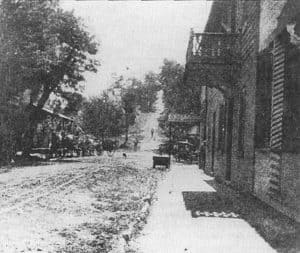Commercial Development Timeline for Waterford
From its beginning, Waterford was a thriving commercial center. Waterford's commercial development peaked, with the exception of the war years, between 1850 and 1875. The village was home and work place to millers, tanners, carpenters, blacksmiths, wagon makers, wheelwrights and also cabinet makers and chair manufacturers.
In 1871 the railroad by-passed Waterford and the village entered into a slow decline. The Quaker Fairfax Meeting was laid down in 1929. When the Historic American Buildings Survey made a photographic record of Waterford in 1937 much of the village was derelict![]()
Waterford's historical timeline »
|
Waterford's Commercial Development Timeline |
|
|
1733-1800 |
Clustered at the intersection of First, Bond and Main Streets, Waterford's earliest development consisted of a mill, a miller's house, a blacksmith shop, and a cabin. There was a strong Quaker influence. |
|
1790
|
The first expansion of the town occurred whenJoseph Janney subdivided and sold lots on the south side of Main Street. Today most houses on both sides of Main date to late 1700s and early 1800s. |
|
1800-1860
|
During this period Waterford became one of the county's major- farming and manufacturing centers. |
|
1800
|
The second expansion extended Main Street up the "big hill" as far as High Street. Existing historic houses along this street generally date from 1804-1815. |
|
1803
|
Lots begin to be sold on the Main Street end of Second Street. |
|
1809
|
Subdivision opens on Patrick Street between Second and High Streets. |
|
1820s
|
Area from Patrick Street to Factory Street including both Second and High Streets plotted- and sold, beginning "New Town." |
|
1830-1860
|
Construction limited to Second Street and its intersecting streets (Church, Patrick, and Mahlon). Set apart from the main residential and commercial areas, Factory Street began as a manufacturing section for Steer & Schooley's "cold iron" factory. 1865- |
|
1830-1840
|
Railroads and roads bypass Waterford |
|
1880
|
After the Civil War, while suspended commercial enterprises returned, construction never regained its former momentum. |
|
1885-1905
|
Houses were built on remaining lots on Second Street while lots on High, Main, and Patrick Streets were laid out and built upon. Factory Street was redeveloped as a residential area. First automobiles arrived. |
|
1900-1930
|
Building boom stops. Waterford becomes interested in emerging national historic preservation consciousness (Historic Sites Act - 1935). |
|
1920s
|
The few houses built after 1900 were in early 20th century American Foursquare style. |
|
Late 1930s
|
Edward and Leroy Chamberlin began restoring historic homes and removing Victorian additions. |
|
1930s-1960s
|
Some new buildings were designed in Colonial Revival style, often copying important colonial buildings. |
|
1977-present
|
Since its designation as a Historic and Cultural Conservation District in 1977, additions, alterations, and new buildings are checked for appropriateness by the county Historic District Review Committee. |
